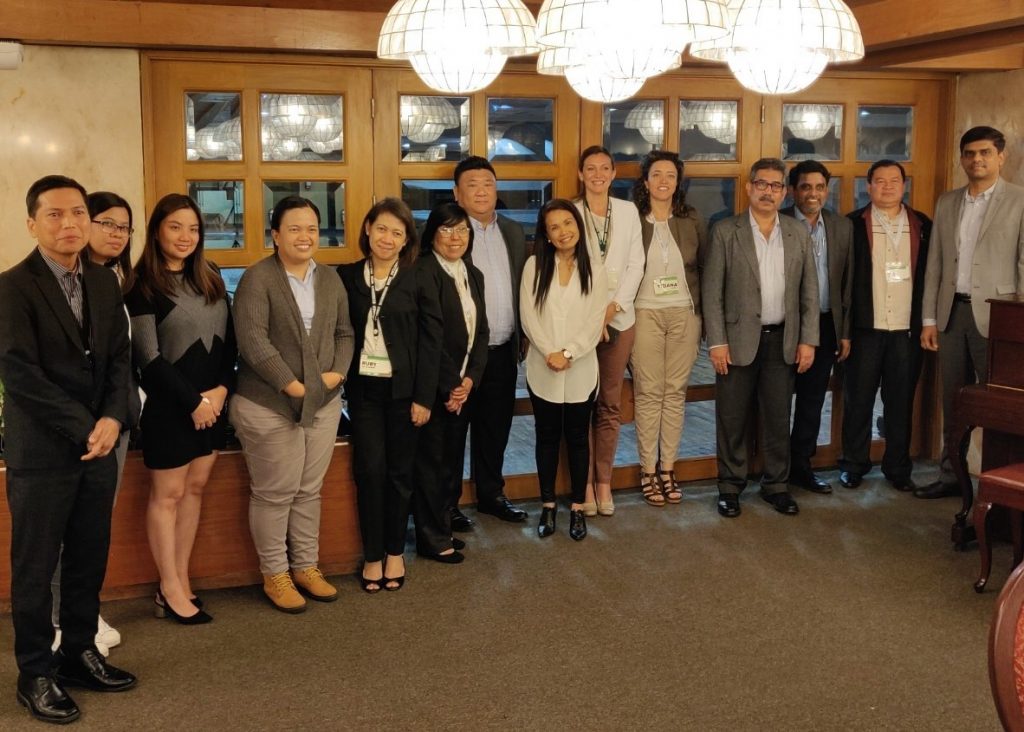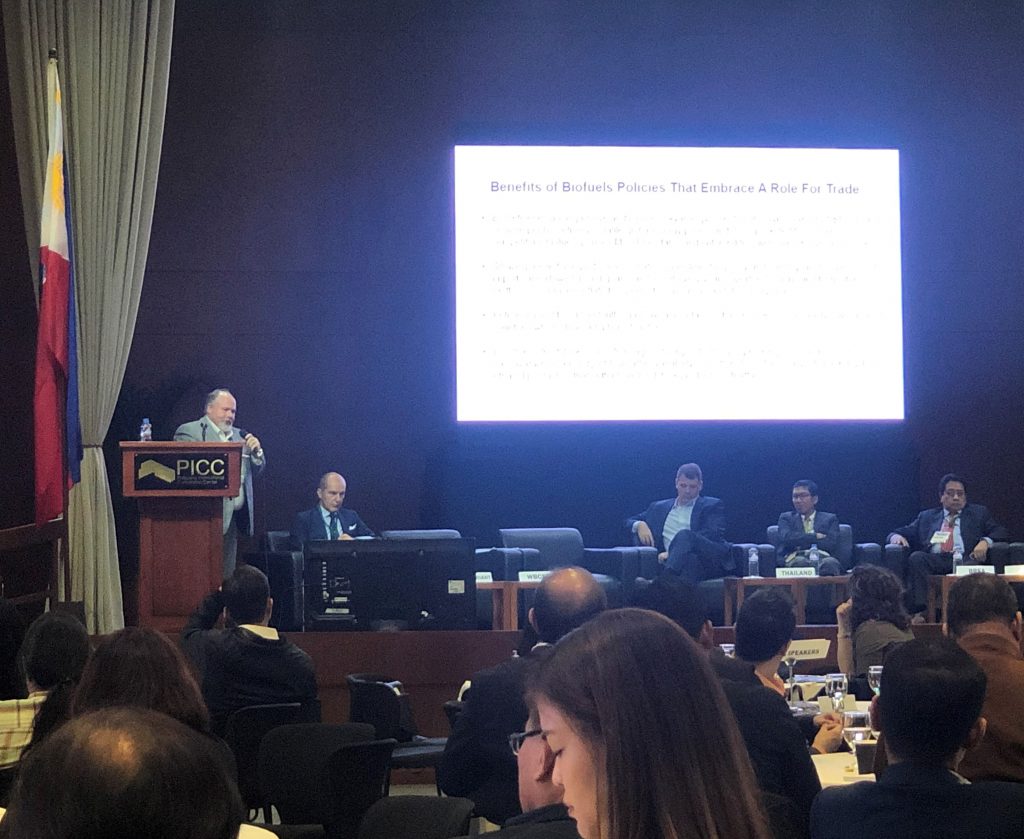The seventh annual Bioenergy Week of the Global Bioenergy Partnership (GBEP) provided an opportunity for the U.S. Grains Council (USGC) to highlight how the government and private industry in the Philippines cooperate to promote ethanol to a delegation of sugar-based ethanol producers from India.
The Council sponsored the delegation to connect thought leaders from both countries as the Indian government considers ethanol policy changes that could create a robust new market for fuel ethanol.
The GBEP is a global group that connects public, private and civil society stakeholders to promote bioenergy for sustainable development. The Bioenergy Week forum, held in Manila in June, brought together ethanol industry leaders from eight countries across South and Southeast Asia to provide updates on the programs and policies in their specific markets. Tim Tierney, USGC director of strategic marketing/ethanol – North Asia, spoke as part of a panel on the economic, environmental and human health benefits of increased ethanol use.
“The GBEP has a wide perspective on bioenergy from biogas and waste to energy systems,” Tierney said. “The 2019 Bioenergy Week was organized to foster discussion and exchange of experiences and skills related to the practicality of sustainable bioenergy services in Asia. The Council sponsored the Indian delegation to learn about trade flows for ethanol and specifically about the Philippines ethanol industry as a potential model for their own industry expansion.”
The Philippines ethanol industry is a two-tiered market system in which domestic ethanol and imported supplies co-exist. Domestic producers, which currently use sugarcane or molasses as feedstock, provide the primary supply of ethanol to meet the country’s E10 blend mandate. The government also provides incentives for building new ethanol plants, which has increased ethanol production to 62 million gallons (235 million liters) and capacity utilization to 83 percent.
With these supports in place, domestic supplies can provide roughly half the ethanol needed to fill the blend mandate. The rest of the demand is met through the second tier of the system – imports, allowed after domestic production is exhausted. Even as domestic production has expanded, ethanol imports have also grown as fuel demand expands due to population increases, rising middle class incomes and an expanded vehicle fleet.
As a result, the Philippines continues to be a consistent buyer of U.S. ethanol, ranking as the sixth largest buyer with sales of 64.3 million gallons (2.53 billion bushels in corn equivalent) thus far in the 2018/2019 marketing year (Sept. 2018-May 2019).
“The story of how ethanol producers, trade groups, government agencies, regulatory boards and even oil companies work together in implementing an E10 mandate in the Philippines is a true success,” said Kent Yeo, USGC regional ethanol consultant for Southeast Asia. “The ethanol industry is also actively working to diversify its feedstock supply options to continue expanding ethanol production and work toward a target of an E20 mandate.”
As part of this work, the Philippines groups are now working on legal, research and implementation fronts to evaluate options to use corn or sorghum as additional feedstock options.
This interorganizational cooperation between government and private industry provides a potential model for India as the government there is working on refining its own ethanol policies. India’s government has proposed blend rates of up to 20 percent. Yet, current policies restrict the import of ethanol destined for fuel use, relying instead on domestic supplies of sugarcane to produce ethanol for fuel and importing U.S. ethanol only for industrial use. India currently has an average blend rate of 6.1 percent, but the blend rates vary between states from zero to 3.1 percent to 8 to 9.5 percent. Overall, blend rates are trending down slightly as ethanol production has slowed and supplies have decreased.
While in the Philippines, the Indian delegation had side meetings with industry, university and government representatives to discuss the two-tier system and how public-private work has achieved cost-savings and environmental benefits – both important considerations for India.
“If India would implement an E10 blending mandate using domestic and imported ethanol, similar to the Philippines, cost-savings could range between $2.87 to $3.12 billion,” said Amit Sachdev, USGC consultant in India. “A consistent availability of ethanol across the country will not only save money, but also ensure lower particulate matter, improving air quality.”
Access to the fuel sector would also benefit global ethanol exporters. The country is already the third largest market for U.S. ethanol, despite only importing ethanol for industrial uses. India has imported 163.3 million gallons (57.9 million bushels in corn equivalent) of U.S. ethanol in 2018/2019, a 32 percent increase that continues an upward trend over the last five marketing years.
“Gaining access to the fuel market for imported ethanol would create a robust new market and lead the way for other markets in the region to develop similar policies with a role for trade,” Sachdev said. “The Council will continue to monitor these growing markets and engage ethanol leaders about the benefits of expanding global ethanol use.”
The Council has invited delegations from both India and the Philippines to continue their discussions on fuel ethanol use at the Global Ethanol Summit in October 2019 in Washington, D.C., along with more than 250 ministerial-level officials and senior-level industry leaders, ethanol producers and refiners from more than 40 countries.
The Summit will include informative general sessions, networking and dedicated business-to-business meetings over two days, sponsored by the Council, Growth Energy and the Renewable Fuels Association (RFA).
Following the Summit, the Council and its members will organize specialized tours of U.S. ethanol production facilities and terminals for international attendees, providing additional familiarity with U.S. suppliers.
Learn more about the Council’s work to promote global ethanol use.
About The U.S. Grains Council
The U.S. Grains Council develops export markets for U.S. barley, corn, sorghum and related products including distiller’s dried grains with solubles (DDGS) and ethanol. With full-time presence in 28 locations, the Council operates programs in more than 50 countries and the European Union. The Council believes exports are vital to global economic development and to U.S. agriculture’s profitability. Detailed information about the Council and its programs is online at www.grains.org.


